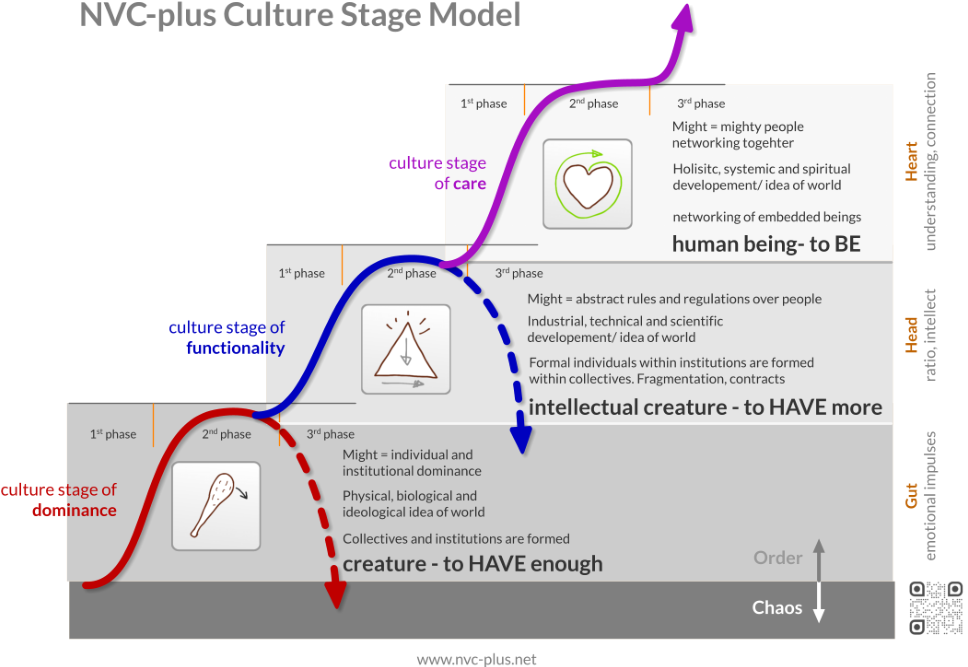
Cultural Stage Model
How to turn your team
into the boss


- The 6 Hurdles
- The Elements
- What are the Elements
- Culture Stage Model
- Gut, Head or Herart Process
- Culture Change
- List of Feelings and Needs
- Emergency Emo-Step
- Four Step Circle
- NVC Magic Circle
- Utopia Magic Circle
- Utopia and Vision
- No-Goes and Must-Haves
- Pain Points
- Consensus
- Requirement Lists
- NVC-plus Strategy
- NVC-plus Matrix
- Discourse
- Card Set
- Download-Tool-Depot
- FAQs
- Events
- Media

6 Hurdles to Self-Organization
Chapter 03 – The Cultural Stages Model



Home / hurdle 1: team culture / culture stage model

Successful
cooperation
is
both
a
path
and
a
goal.
Good
methods
and
tools
make
it
much
easier
for
a
team
to
organize
itself.
Encourage
your
team
to
take
the
first
steps
in
this
direction
and
experience the difference.
According
to
the
culture
stage
model,
there
are
three
different
cultural
stages
in
systems.
They
show
the
gradual
path
from
working
against
each
other
to
working
with
each
other.
The
culture
of
communities
develops
step
by
step
in
such
a
way
that
people
can
live
their
humanity
better
and
better.
Organic
self-
organization is only possible at the last of these three cultural levels
.
The
cultural
stages
build
on
each
other
and
each
of
these
three
cultures
has
a
constructive
and
a
destructive
phase.
We
suspect
that
we
rarely
achieve
anything
good
with
dominance
-
the
dark
side
of
power
-
today.
But
in
anarchic
and
chaotic
times,
brute
strength
often
creates
the
first
order.
Boss
becomes
the
strongest
individual,
later
the
strongest
group
and
then
the
strongest institution.
But
in
the
course
of
time,
a
dominant
culture
must
be
replaced
by
the
culture
of
functionality,
because
otherwise
it
breaks
down
due
to
the
complexity
of
the
structures
it
has
created.
This
is
also
the
case
at
the
next
level.
The
culture
of
functionality
does
not
work
with
personal
strength,
but
with
rules
and
laws.
This
creates
a
more
efficient
and
therefore
more
favorable
order.
It
is
no
longer
the
strong
who
dominate,
but
logic,
technology,
science
and
the
legal
system
that
determine
the
organization.
The
age
of
inventions,
engineering
and
researchers
has
begun.
Well
"functioning"
people
create
a
new
prosperity
together.
But
they
are
hardly
happy,
because
they
are
not
working
for
themselves
and
their
goals,
but
for
money.
Work
and
life
seem
like
two
pairs
of shoes. And the basis of functionality is usually still old hierarchical structures of dominance.
Today,
we
are
increasingly
living
in
the
late
phase
of
the
culture
of
functionality.
In
many
places,
it
has
already
passed
its
zenith
and
even
with
more
rules
and
regulations,
we
can
no
longer
properly
regulate
the
increasingly
complex
interaction,
neither
in
private,
professional
or
social
contexts. What would be the next step?
The
next
culture
is
one
of
mutually
supportive
cooperation.
It
is
the
culture
of
practiced
caring.
We
support
others
on
their
paths
and
in
their
work
and
we
are
supported
by
others
in
our
work
and
goals.
We
can
easily
define
and
achieve
common
goals.
We
have
a
good
sense
of
ourselves
and
others.
There
is
trust
and
inspiration
here,
because
shame
belongs
to
the
first
cultural
level
and
guilt
to
the
second.
At
the
cultural
level
of
caring,
we
flexibly
entangle
our
strengths
and
weaknesses
in
order
to
be
strong
together.
Work
and
life
are
no
longer
artificially
separated.
"Work"
is
our
effectiveness
and
involvement
and
therefore
a
good
part
of
our
lives.
We "live it up", as the saying goes.
If
we
don't
take
the
step
into
this
caring
culture,
things
will
quickly
go
downhill
again.
Cooperation
would
ultimately
fail
because
of
individuality,
which
would
naturally
become
stronger
and
stronger
at
the
functional
level
of
culture.
Unfortunately,
the
culture
of
functionality
cannot deal with individuality.
Where
collaboration
fails,
the
system
soon
finds
itself
in
a
culture
of
dominance
or
even
chaos.
But
if
we
simply
move
forward
courageously,
self-determined
individuals
will
come
together
freely
to
form
self-organized
teams
and
projects,
and
the
evolution
of
cooperation
will
emerge
as a peaceful (r)evolution of hearts.
Self-organization
at
the
team
level
is
not
difficult,
but
this
only
applies
to
teams
that
operate
within the culture of caring. Therefore, the first task is to switch to the culture of care.
1
.
The culture of dominance
Dominanz der starken Menschen
und Institutionen
2
.
The culture of functionality
Dominance of the rules
3
.
The culture of care
Dominance of the heart


Every team, start-up, or company must overcome these six hurdles if it wants to organize itself
collegially in order to successfully manage projects from within the community.


Cultural Stage Model


2. Pyramid
(functional order)
3. Heart
(caring order)

1. Mace
(dominant order)


a)
Culture Stage Model





Chapter 03 – The Cultural Stages Model


- The 6 Hurdles
- The Elements
- What are the Elements
- Culture Stage Model
- Gut, Head or Herart Process
- Culture Change
- List of Feelings and Needs
- Requirement Lists
- NVC Magic Circle
- Utopia Magic Circle
- Emergency Emo-Step
- Four Step Circle
- Utopia and Vision
- No-Goes and Must-Haves
- Pain Points
- Consensus
- NVC-plus Strategy
- NVC-plus Matrix
- Discourse
- Card Set
- Download-Tool-Depot
- FAQs
- Events
- Media
According
to
the
culture
stage
model,
there
are
three
different
cultural
stages
in
systems.
They
show
the
gradual
path
from
working
against
each
other
to
working
with
each
other.
The
culture
of
communities
develops
step
by
step
in
such
a
way
that
people
can
live
their
humanity
better
and
better.
Organic
self-organization
is
only
possible
at
the last of these three cultural levels
1
.
The culture of dominance
Dominanz der starken Menschen
und Institutionen
2
.
The culture of functionality
Dominance of the rules
3
.
The culture of care
Dominance of the heart
The
cultural
stages
build
on
each
other
and
each
of
these
three
cultures
has
a
constructive
and
a
destructive
phase.
We
suspect
that
we
rarely
achieve
anything
good
with
dominance
-
the
dark
side
of
power
-
today.
But
in
anarchic
and
chaotic
times,
brute
strength
often
creates
the
first
order.
Boss
becomes
the
strongest
individual,
later
the
strongest
group
and
then
the
strongest
institution.
But
in
the
course
of
time,
a
dominant
culture
must
be
replaced
by
the
culture
of
functionality,
because
otherwise
it
breaks
down
due
to
the
complexity
of
the
structures
it
has
created.
This
is
also
the
case
at
the
next
level.
The
culture
of
functionality
does
not
work
with
personal
strength,
but
with
rules
and
laws.
This
creates
a
more
efficient
and
therefore
more
favorable
order.
It
is
no
longer
the
strong
who
dominate,
but
logic,
technology,
science
and
the
legal
system
that
determine
the
organization.
The
age
of
inventions,
engineering
and
researchers
has
begun.
Well
"functioning"
people
create
a
new
prosperity
together.
But
they
are
hardly
happy,
because
they
are
not
working
for
themselves
and
their
goals,
but
for
money.
Work
and
life
seem
like
two
pairs
of
shoes.
And
the
basis
of
functionality
is
usually
still
old hierarchical structures of dominance.
Today,
we
are
increasingly
living
in
the
late
phase
of
the
culture
of
functionality.
In
many
places,
it
has
already
passed
its
zenith
and
even
with
more
rules
and
regulations,
we
can
no
longer
properly
regulate
the
increasingly
complex
interaction,
neither
in
private,
professional
or
social
contexts.
What
would
be the next step?
The
next
culture
is
one
of
mutually
supportive
cooperation.
It
is
the
culture
of
practiced
caring.
We
support
others
on
their
paths
and
in
their
work
and
we
are
supported
by
others
in
our
work
and
goals.
We
can
easily
define
and
achieve
common
goals.
We
have
a
good
sense
of
ourselves
and
others.
There
is
trust
and
inspiration
here,
because
shame
belongs
to
the
first
cultural
level
and
guilt
to
the
second.
At
the
cultural
level
of
caring,
we
flexibly
entangle
our
strengths
and
weaknesses
in
order
to
be
strong
together.
Work
and
life
are
no
longer
artificially
separated.
"Work"
is
our
effectiveness
and
involvement
and
therefore
a
good
part
of
our
lives. We "live it up", as the saying goes.
If
we
don't
take
the
step
into
this
caring
culture,
things
will
quickly
go
downhill
again.
Cooperation
would
ultimately
fail
because
of
individuality,
which
would
naturally
become
stronger
and
stronger
at
the
functional
level
of
culture.
Unfortunately,
the
culture
of
functionality cannot deal with individuality.
Where
collaboration
fails,
the
system
soon
finds
itself
in
a
culture
of
dominance
or
even
chaos.
But
if
we
simply
move
forward
courageously,
self-determined
individuals
will
come
together
freely
to
form
self-organized
teams
and
projects,
and
the
evolution
of
cooperation
will
emerge
as
a
peaceful
(r)evolution of hearts.
Self-organization
at
the
team
level
is
not
difficult,
but
this
only
applies
to
teams
that
operate
within
the
culture
of
caring.
Therefore,
the
first
task
is
to
switch
to
the
culture of care.
.
Successful
cooperation
is
both
a
path
and
a
goal.
Good
methods
and
tools
make
it
much
easier
for
a
team
to
organize
itself.
Encourage
your
team
to
take
the
first
steps
in
this
direction
and
experience
the
difference.






































